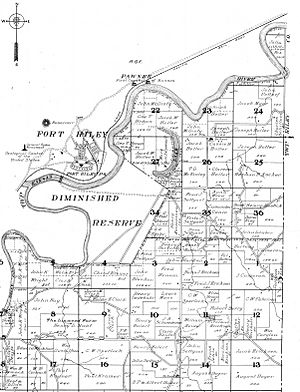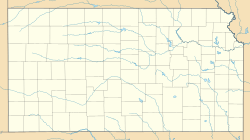Pawnee, Kansas facts for kids
Quick facts for kids
Pawnee, Kansas
|
|
|---|---|

The plats of northern Jefferson Township, Geary County, Kansas, showing Fort Riley and Pawnee across the Kansas River. 1909.
|
|
| Country | United States |
| State | Kansas |
| County | Geary |
| Named for | Pawnee people |
| Elevation | 1,053 ft (321 m) |
| Population | |
| • Total | 0 |
| Time zone | UTC-6 (CST) |
| • Summer (DST) | UTC-5 (CDT) |
| Area code | 785 |
| GNIS ID | 482209 |
Pawnee is a ghost town in Geary County, Kansas, United States. It was once the very first official capital of the Kansas Territory in 1855. But Pawnee was only the capital for a very short time – just five days! The government leaders met there from July 2 to July 6. Then, they voted to move the capital to Shawnee Mission, which is now part of Fairway. Pawnee might be the capital that lasted the shortest time in any U.S. state or territory.
Contents
History of Pawnee
Early Days of Kansas
For thousands of years, the Great Plains of North America were home to nomadic Native American tribes. In the 16th to 18th centuries, France claimed large parts of North America. After a war, France secretly gave this land to Spain in 1762. Then, in 1802, Spain gave most of it back to France.
In 1803, the United States bought most of the land that is now Kansas from France. This huge purchase, called the Louisiana Purchase, covered 828,000 square miles. The U.S. paid about 2.83 cents per acre. In 1854, the Kansas Territory was officially created.
Starting the Town of Pawnee
Pawnee was named after a native tribe that lived in the area. It was located on the far western edge of the Kansas Territory. It sat between the new town of Manhattan, Kansas, and the U.S. Army base at Fort Riley. Pawnee was first planned out in 1854.
The commander of Fort Riley, Colonel William R. Montgomery, allowed investors to buy 400 acres. These investors believed the land was part of the military area. In late 1854 or early 1855, the first Territorial Governor, Andrew Reeder, chose Pawnee as the capital. Governor Reeder had a financial interest in the town. He was one of the investors and a new landowner there.
His choice paid off quickly. Within six weeks of his announcement, hundreds of people moved to Pawnee. The town quickly grew with new homes, stores, and hotels. Governor Reeder soon built a two-story log cabin, which became known as the "Governor's Mansion."
Choosing Government Leaders
Before the first election for representatives, Governor Reeder did not take a proper count of the people living in the territory. The census in February 1855 showed only 36 residents in Pawnee. However, 75 votes were cast there in the March 30 election. These extra votes came from new settlers who had arrived that month.
But in other parts of the territory, many votes were cast illegally. More than 800 illegal votes were found in both Lawrence and Leavenworth. Overall, over 4,000 illegal votes were cast across the territory.
People who wanted Kansas to be a free-state (without slavery) were helped by new settlers from New England. These settlers were supported by the Emigrant Aid Company. However, many free-staters felt that Governor Reeder had purposely delayed the election. They thought he did this so that pro-slavery men from nearby Missouri could arrive and vote. These Missouri residents took over polling places and threatened legal voters. In the end, only 8 of the 39 elected men wanted Kansas to be a free-state.
Five Days as Capital
The Territorial Legislature first met in Pawnee on July 2, 1855. Most of the delegates had been unfairly elected and supported slavery. They were unhappy that Governor Reeder had placed the capital over 100 miles from the Missouri border. They felt this location favored those who wanted Kansas to be a free-state. This was exactly what Governor Reeder intended. He believed a free Kansas would help his own land investments.
The pro-slavery leaders quickly took action. They removed all but one of the free-state men from their positions. One man who lost his spot said they were "starting a conflict." The only free-state leader left, Martin Conway, also disagreed with Reeder. During the Governor's opening speech, Conway stood up to criticize the group. He said he would not respect any of their laws.
Despite the Governor and Conway, the leaders quickly voted to move the capital. They chose Shawnee Mission, which was right on the Missouri border. Governor Reeder tried to stop this by using his veto power. He reminded them of the money Pawnee had already spent building the capital city. But the Territorial Legislature ignored his veto. They met next in Shawnee on July 16. Still, Reeder insisted Pawnee was the capital. He vetoed any new laws, believing the lawmakers were not meeting legally.
Because of its unfair start and actions, this group became known as the "Bogus Legislature." The pro-slavery men never planned to stay in Pawnee. They ignored the nearby boarding houses and came ready to camp outside. After they voted to move, the Kansas Legislature never returned to Pawnee. July 6, 1855, was its last day as the capital city. It served for only five days.
The End of Pawnee
Soon after Pawnee stopped being the capital, in September 1855, Jefferson Davis, who was the Secretary of War, looked at the town. He showed his findings to U.S. President Franklin Pierce. On the map, the eastern border of Fort Riley was shown both with and without Pawnee. The lines that excluded the town were accepted.
It was ordered that Pawnee be destroyed and its land returned to Fort Riley. Notices signed by President Pierce were put on every building. They told everyone to leave by October 10. A Major Cook and 1,000 of his Texas troops were tasked with moving the residents. Many people did not want to leave. By the night of October 10, some residents were still there. The Governor's Mansion, which Governor Reeder had left, was torn down with its new residents still inside. In another home, a woman and her baby were carried out on a mattress and taken across the military border. Most of the buildings, including all the houses, were destroyed. This caused many families to lose everything. Other Kansas towns that developed in similar ways, but without strong free-state supporters, did not face the same fate.
Pawnee Later and Today
Many residents left Pawnee with the government leaders right after they moved on July 6. Those who stayed faced a cholera outbreak in August. Fort Riley was also affected. Union Pacific Railroad lines reached the abandoned town in 1866. This was part of a railroad route approved by the Pawnee legislature. The tracks passed just yards from the north side of the capitol building. The railroad went through Pawnee partly because the nearby river was not always reliable for boats.
First Territorial Capitol State Historic Site
Jefferson Davis had decided that most of Pawnee was inside Fort Riley's boundaries. Only the capitol building was saved from being torn down. During its short time as the meeting place for the government, it was not very comfortable. The floorboards were not nailed down, and there was still a hole in the outer wall on the second floor from construction.
After the government left, townspeople went into the building. One person said they found "...a room full of confusion and disorder. Torn pamphlets, scraps of papers, and rubbish of all descriptions were scattered about." The building was later used as a warehouse.
The building is now listed on the National Register of Historic Places. It is still inside the military base. Over the years, it has been used for many different things. It was a church, a club for single men, housing, and a carpentry shop. In the 1920s, the Kansas Historical Society and Union Pacific took care of the building and fixed it. It was officially reopened in 1928 with a big celebration and became a history museum. In 1961, the state government met in the Pawnee capitol again for one day. This was part of the state's 100-year anniversary celebrations.
Today, the museum has exhibits about the Kansas Territory. It also shows how people traveled by rail and river in the area. You can also learn about the history of Pawnee. Since it is on a military base, you need to make plans ahead of time to visit the museum. There is also a driving tour of the base. It includes several historic places, like the First Territorial Capitol.




